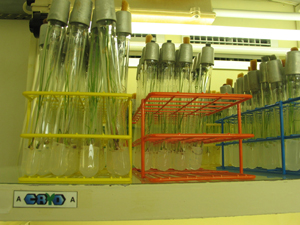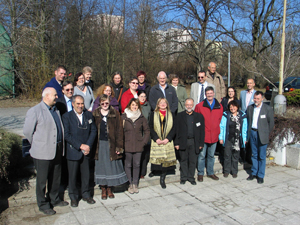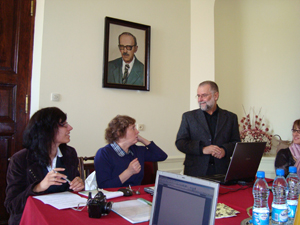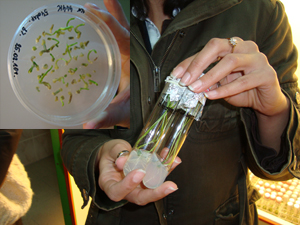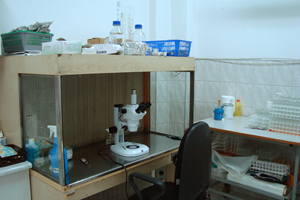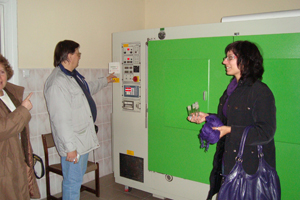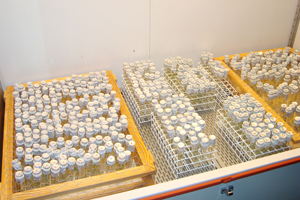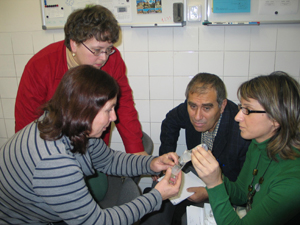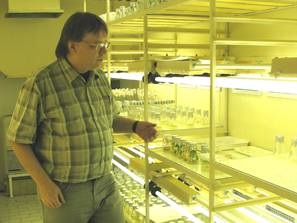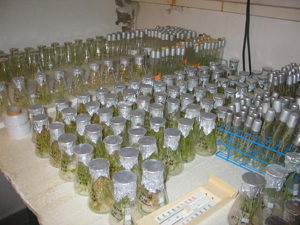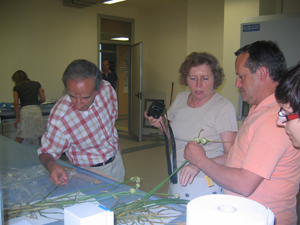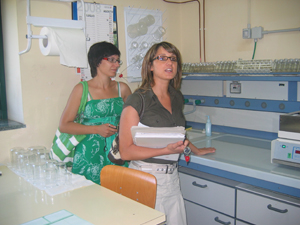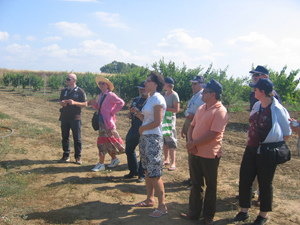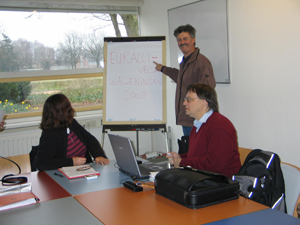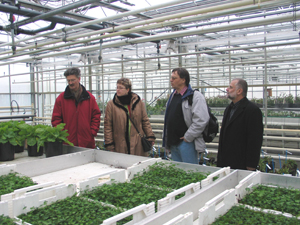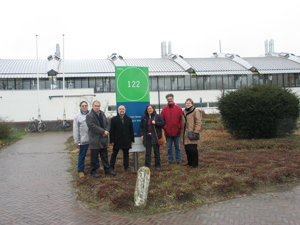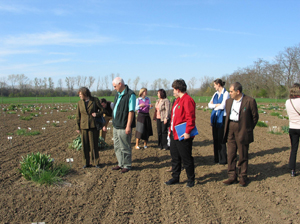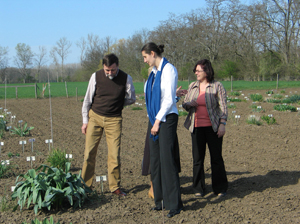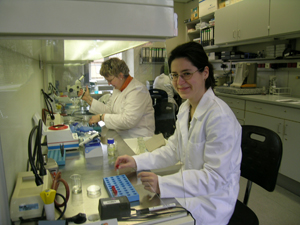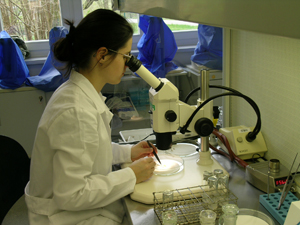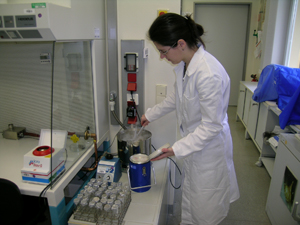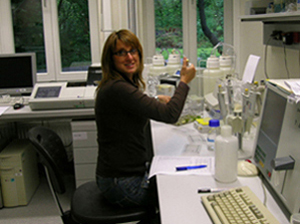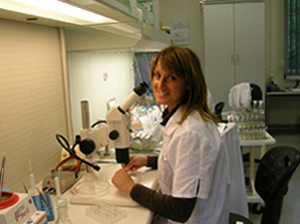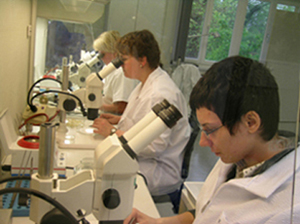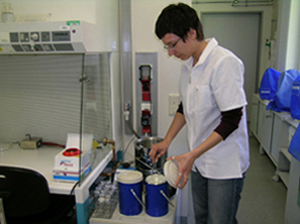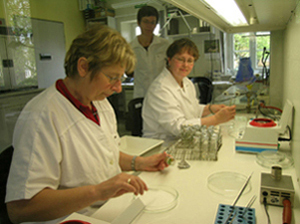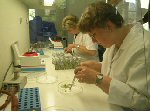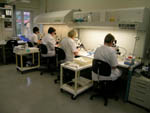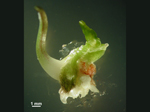Activities |
||||||||||||||||||||||||||||||||
|
|
||||||||||||||||||||||||||||||||
March 1-2, 2011: Final Project Meeting at CRI, Prague, Czech Republic
The meeting started with a welcome of the Head of the Department Molecular Biology, Jaroslava Ovesná. She presented the structure
and the aims of the Crop Research Institute and welcomed the participants. The project coordinator Joachim Keller introduced then
the guests to the meeting, Olivier Diana (GENRES office Brussels), Dave Astley (Chairman of the ECPGR Allium Working Group),
Jan Engels (AEGIS Coordinator), Ana Maria Barata da Silva (Portuguese Genebank), Francisco Mansilla (Garlic Collection CIFA
Cordoba, Spain).
Finally some other documentation needs were stressed by Joachim Keller (P0): a document about the safety duplication including the
legal aspects, a booklet about methods and technical guidelines and an action plan for the future management and further strategy.
A press conference about EURALLIVEG was held in order to increase the awareness of the project in the public of the Czech Republic.
It was presented by Olivier Diana, Jan Engels, Joachim Keller (P0), Jaroslava Ovesná, Helena Stavělíková (P1) and
Jiří Zámečník (P1).
March 9-10, 2010: Third Annual Project Meeting at RIVC (now InHort), Skierniewice, Poland
The meeting started with the welcome, given by the Director of RIVC, Franciszek Adamicki, and the main organizer Teresa
Kotlinska (P2) and was opened by the coordinator, Joachim Keller (P1), followed by a short introduction of all participants.
The aims of the meeting were the annual reporting of the results, discussions on achievements and problems of the last year as well as
to point out which requirements are needed to fulfil the project parameters. The first presentation was a general review of the project
philosophy and the international situation of the genetic resources preservation, which is the background for the project. It was given
by Joachim Keller. The final composition of the garlic core collection was discussed by Christine Zanke (P0). IPK (P0) will
contribute with 36 bolting and 20 non-bolting accessions, CRI (P1) with 36 and 26 and RIVC (P2) with 37 and 20, respectively.
The Italian (non-bolting) material will be split into 9 accessions for P0 and 6 for P1. The French material (6 accessions) will be stored
by P1. Since the structuring by means of molecular markers is not possible yet, the final documentation of the 200 accessions of the
cryopreserved core collection needs to be focussed onto morphological description and passport data.
For this examples were given.
Since the total of the backbone set is still not reached, UNIBAS needs to test the material further for all 5 viruses in order to have the option to rearrange the plants designated for the main virus elimination set into the backbone set in case fully virus-free material could be obtained. Concerning the main virus elimination set, the re-sending to the partners started with 2 accessions to P0, 4 acc. to P1, and 2 acc. to P2. Others are ready to be tested by ELISA. Discussion arose concerning the field performance tests planned by UNIBAS. Due to the delay in the fulfilment of the backbone set, it will not be possible to do a full performance test within the project period. Helena Stavělíková (P1) presented the situation of the field management and virus elimination activities at the Olomouc collection place. The special situation of the Polish garlic collection, which includes 373 accessions, was presented more in detail by Teresa Kotlinska (P2) at the beginning of WP3 (Cryopreservation). The partners presented their accessions already being in cryopreservation. In total 59 bolting, 11 non-bolting and one accession of the backbone subset were cryopreserved, which means, that only 35.5 % of the required 200 cryopreserved accessions are finished. Planning and logistics of safety duplicate exchanges was discussed by Jiří Zámečník (P1). He presented the planned transport route coming from Prague via Gatersleben to Skierniewice and retour. This will be done in an open transport car driven by a staff member of CRI. The distance is 2200 km in total. The day was ended by a visit to the laboratory of P2 guided by Marta Olas-Sochacka and Teresa Kotlinska. The plantlets in the preculture phase were presented. Their quality is well-suited for cryopreservation. One of the main progress steps is that the laboratory got a new clean bench, which improves the work power for in vitro culture and cryopreservation. At the second day Chris Kik (P4) reported on the problems appearing during the molecular screening, which resulted in a general failure of the SNP analysis. No concluding duplicate screening could be done. Additional activities at IPK were presented by Christine Zanke (P0). At the end, only four primers were found to be really usable, which is by far too insufficient. Concluding discussions were followed how to proceed with the molecular analysis in order to find finally some results. Svein Solberg (P6) is a new representative of NordGen replacing Agnese Kolodinska Brantestam, who is in maternity leave. He presented the new structure of NordGen. Florence Esnault (P5) gave a summary about the contribution of INRA to the project consisting of providing standard material of shallot according to the presentation of Le Thierry D’Ennequin et al. (1997). Christine Zanke (P0) summarized the obtained results and gave an overview about the meetings so far organized. At the end, the delay of fulfilling deliveries and milestones in comparison to the project document was characterized. The deadline for the delivery of the contributions of the next financial and technical annual reports was fixed. Since the core collections of garlic and shallot need to be documented until summer 2010, it is now necessary to fix the accessions finally. A list of the final accessions needs to be sent to Christine Zanke by March 19, 2010, and will be included in the next annual technical report. Joachim Keller (P0) concluded the meeting with the expression of hope that, in the last project year, all efforts will be concentrated on fulfilment of the parameters as good as possible to give the activities to continue the European Garlic and Shallot Core Collection a good perspective beyond the project period. The day was ended by a piano performance in the concert hall of the institute’s main building giving a very good concluding atmosphere and encouragement for further activities together in the project. The participants thank the well-organized and dedicated activities of Teresa Kotlinska, Marta Olas-Sochacka and the other staff of the laboratory to give the meeting a good background.
October 20, 2009: Small Technical Meeting Cryopreservation and In vitro Culture" at RIVC (now InHort) Skierniewice, Poland
The local organizer was Teresa Kotlinska, Research Institute of Vegetable Crops (RIVC, now renamed to InHort), together with her colleagues.
The main aim of the meeting was the updating of work results and discussion of technical and technological details of in vitro
culture and cryopreservation in WP 3, mainly to facilitate technology transfer between the participating laboratories.
The meeting was opened by a warm welcome of Franciszek Adamicki, the director of RIVC, and a small visit to the historical
main building of the institute, where a part of the meeting was conducted.
January 27, 2009: Special technical Meeting for WP 2: Molecular Screening at IPK, Gatersleben
The meeting was organized to discuss the further progress of the molecular marker analysis for
duplicates and to overcome some difficulties observed in the last period. The programme was structured
into four presentations which were provided at the internal website, a problem discussion and an agreement
what will be done in the next three weeks.
Finally it was emphasized by all participants, that the problems so far occurring are problems of the whole project community and not only of one of the participants. Insofar, it is in the interest of all of us to overcome that as much as possible. Correspondingly, the meeting was performed in a very constructive and collegial atmosphere.
December 4, 2008: Small technical meeting for WP 3: Quality Management of the In Vitro Culture and Cryopreservation Processes" at CRI, PragueThe local organizer was Jiří Zámečník, Crop Research Institute (CRI, P1), together with his colleagues. The meeting was organised to improve the knowledge and abilities of the participants with respect to the various steps of in vitro culture and cryopreservation of garlic. Another aim was to discuss the problems of Cryo-Knife which had been marked by the reviewers of the Brussels office after reviewing the Technical Report. Christine Zanke (P0) presented a Powerpoint presentation starting with the general structure of the accessions to be conserved by each partner. She gave detailed results of P0 and showed typical pictures of in vitro cultures prior to and after cryopreservation. Marta Olas (P2) gave a overview about the results of P2 including pictures of in vitro cultures. Jiří Zámečník (P1) showed a summary table about the whole WP. Afterwards online demonstrations were performed of the standard preparation of explants for cryopreservation from in vitro plantlets or bulbils and meristem explants for virus elimination. The size of explants from bulbils and from in vitro cultures used for cryopreservation is clearly larger than that of meristem explants used for virus elimination. A presentation of the culture rooms and cold rooms for alternating temperature preculture of P1 followed. A decision about the further strategy concerning cryo-knife was made. The meeting showed that such kind of discussions are, indeed, very necessary for the further improvement of collaboration. The meeting was conducted in an open and critical atmosphere, which was supported by the informal character of the meeting. The organiser Jiří Zámečník (P1) offered a very good surrounding by all the social background activities like lunch and dinner and an easy-to-reach accommodation.
July 08-09, 2008: Second annual project meeting at UNIBAS, PotenzaThe local organizer was Vito Miccolis (P3), University Potenza, together with his colleagues. They provided a perfect organization of all the events and the transportation and were very perfect in organising local services. The aim of the meeting was the annual reporting of the results, discussions on achievements and problems of the first year as well as on the further programme and to see the special situation of the garlic laboratory and field work of the Italian Partner P3. Also methodological and logistic questions had been discussed. Joachim Keller (P0) revised the general strategy of the project referring on the situation of genetic resources in garlic and shallot and gave a short report of the AEGIS activities. Then Kristiina Antonius presented the Nordic Genebank System and its recent changes. The main feature is a closer connection between plant, animal and forest genetic resources. Christine Zanke (P0) discussed the numbers, the selection criteria and classification of accessions provided to the project together with the official duplicates known by comparing the data sets of the European Allium Database. The different WPs were reminded and the overlapping nature of the tasks cryopreservation and virus elimination was, again, justified. In order to clear up the responsibilities of the partners, the specific numbers of accessions for each group was presented as it became also a part of the annexes to the project report. For WP2, molecular markers, an overview about the preparation steps to produce the DNA and the justification of the work, which consists in a cost reduction when eliminating undesired redundancy, was given by the WP leader. Chris Kik (P4) pointed out that the subcontractor Array-On (and his collaboration partner GenXPro) had difficulties which results in a delay of 2.5 months. Then the main cryopreservation results were reported by the different project partners. Vito Miccolis (P3) gave an overview about the accessions provided by the partners for virus elimination for the backbone subset and further details were given about the material transfers and movement. Luciana Altieri (P3) added more details on the accessions used for virus elimination and pointed out that there were some unforeseen problems. Later the practical details were discussed at the place where the work is running, which concerns the laboratories of the University of Basilicata. A visit to the fields of the Metaponto farm completed the programme. The participants finally visited the vegetable processing company "Centrone" at Conversano, which is mainly active in producing conserves, amongst them also such of bulbous crops.
March 06, 2008: Additional WP Leaders’ Meeting at CGN, WageningenThe local organizer, Chris Kik, CGN Wageningen (WP leader P4), ensured perfect organization of the meeting including hotel reservation, local transportation and meeting dinner. The aim of the meeting was to prepare the first year’s annual interim reports and to further improve the internal communication between all the work package leaders. After a short welcome by Chris Kik (WP leader, P4) the actual activities and results of the work packages were discussed. For WP1, documentation, Joachim Keller (P0) presented the list of the garlic bolting and non-bolting accessions, which are envisaged to come into cryopreservation in course of the entire project. For WP2, molecular markers, organization and timing were excellent for collecting leaf materials for DNA extraction and their postage as well as the DNA extraction. Problems arose due to the delay in EST marker analyses in garlic. Christine Zanke (P0) and Jiří Zámečník (WP leader, P1) reported about the activities within WP3, Cryopreservation, including amount of accessions in vitro, in cryopreservation and cryo-knife results. Vito Miccolis (WP leader, P3) presented the actual results of the virus elimination. The EURALLIVEG website was presented to all participants. At the end the tables for the declaration of expenses were presented and explained in detail. Finally Chris Kik gave a good introduction into the seed storage and greenhouse reproduction and comparative trials of this well-organized and very active genebank.
April 12-13, 2007: Start-up Meeting at IPK, GaterslebenSoon after the start of the project on April 1, 2007, all participants came to IPK Gatersleben for the first meeting. After the welcome address of the Vice-Director of the genebank, Andreas Börner, and a review of the project documents, two guests gave a presentation. This was first Jan Engels from Bioversity International, Rome, who is responsible there for the European AEGIS policy. He explained the main topics of this strategy. After that, Dave Astley, HRI Wellesbourne, who runs the European Allium Database, presented it as being the fundamental basis for any documentation of accessions related to EURALLIVEG. The main part were the presentation and discussions about the work packages of the project together with a walk through the laboratory of the cryopreservation group and some practical demonstrations, e.g. about freeze-drying for leaf samples used for DNA analyses. The meeting was conducted in a very open atmosphere, characterized by vivid discussion around the nine main talks covering all aspects of the project. At the end, a visit to the Allium fields and to the contracted analysis laboratory of Array-On completed the programme. In the evening, the participants met in an atmosphere of friendship in the Potato House in Quedlinburg.
March 31- April 4, 2008: Training course on techniques of cryopreservation in IPK (P0) for RIVC (now InHort - P2)An additional training course on techniques of micropropagation and cryopreservation of in vitro plants was organised in IPK (PO) for Renata Kotková (CRI, P1). In this one week Renata learned which methods are used for the sterilisation of the bulbils and how to isolate explants under the microscope. She isolated explants which are used for in vitro cultivation or for cryopreservation. In the very short time Renata successfully studied all instructions and helpful information, how to multiply in vitro garlic plants, which media need to be used for cryopreservation and the method for cryopreservation, carried out at IPK. The course was successful for all and a nice pleasure.
May 21 - June 1, 2007: Training course on techniques of virus elimination in IPK (P0) for UNIBAS (P3)The first meeting was very successful. Within these two short weeks we have passed the basic techniques of preparing meristems from ripe bulbs and bulbils from the field and ELISA testing of different plant material to Luciana Altieri (P3). Luciana brought her own material with her, garlic plants from five different accessions. These materials were used for virus screening and establishment of meristem culture. We prepared meristems from sterilized bulbs under the microscope and transferred them to solid growth media, which Luciana took then back to Italy. We made two different ELISA tests with material from bulbs, bulbils, in vitro plants and field plants for testing all important viruses. In the very short time we successfully showed Luciana all instructions and helpful information, which media need to be used for virus elimination and how to multiply in vitro garlic plants.
April 16-27, 2007: Training course on techniques of cryopreservation in IPK (P0) for RIVC (now InHort - P2)Within these two weeks we have passed the basic techniques on cryopreservation to Marta Olas (P2). Marta brought her own material with her, ripe bulbils from last year. We used this material for our cryopreservation training. After the sterilisation of the bulbils, we isolated the explants under the microscope and transferred them to solid growth media. After one day of incubation, the explants were cryopreserved. Marta also learned how to test the survival rates of cryopreserved explants, which media are used for cryopreservation and multiplication of in vitro plants. The course was successful for all and a nice pleasure.
|
||||||||||||||||||||||||||||||||
EURALLIVEG - Activities |
|
|
|
|
|
|

